
Center for Problem-Oriented Policing
The Problem of Clandestine Methamphetamine Labs
What This Guide Does and Does Not Cover
This guide addresses the problem of clandestine methamphetamine§ labs. U.S. state and local police report that methamphetamine trafficking and abuse has become their most pressing illegal drug problem in recent years, surpassing even crack cocaine.[1]
Although offenders manufacture a variety of illicit drugs in clandestine labs [e.g., amphetamines, MDMA (ecstasy), methcathinone, PCP, LSD, and fentanyl], methamphetamine accounts for 80 to 90 percent of the clandestine labs' total drug production.[2] Many of the responses to methamphetamine labs also may be appropriate to other types of drug labs.
§ The drug commonly referred to as "ice" is a smokable form of crystal methamphetamine.
This guide does not provide technical details on all the aspects of clandestine methamphetamine labs.§§ Rather, it provides a general overview of the problem and of responses to it. It begins by describing the problem and reviewing factors that increase the risks of it. It then identifies a series of questions to help you analyze your local problem. Finally, it reviews responses to the problem and what is known about them from evaluative research and practice.
§§ See Bureau of Justice Assistance (1998) [Full text] and Sevick (1993)[Full text] for more technical guidance.
Clandestine methamphetamine labs are but one aspect of the larger set of problems related to illegal drug manufacturing, trafficking, abuse, and associated crime, and a coherent strategy, whether at the international, national, regional, state, or local level, should address all aspects of these problems.§§§ This guide is limited to addressing the particular harms created by clandestine methamphetamine labs. Related problems not directly addressed in this guide include:
- Violent offenses (such as domestic violence and child abuse) committed by drug users, and property offenses to get money to buy drugs or the chemicals to produce them
- Sale and distribution of drugs manufactured in clandestine drug labs
- Abuse of drugs manufactured in clandestine drug labs
- Marijuana grow houses
- Rave parties.
§§§ For comprehensive discussions of pharmacological effects, use patterns, user characteristics, legal status, appearance, ingestion methods, availability, production, and methamphetamine trafficking patterns, see the websites of the U.S. Drug Enforcement Administration, the National Drug Intelligence Center , and the U.S. Office of National Drug Control Policy , as well as Pennell et al. (1999) [PDF] and Eng (1999) [PDF].
Harms Caused by Clandestine Methamphetamine Labs
Clandestine methamphetamine labs cause three main types of harm: (1) physical injury from explosions, fires, chemical burns, and toxic fumes; (2) environmental hazards; and (3) child endangerment.
Physical Injury From Explosions, Fires, Chemical Burns, and Toxic Fumes
Mixing chemicals in clandestine methamphetamine labs creates substantial risks of explosions, fires, chemical burns, and toxic fume inhalation.[3] Those who mix the chemicals (known as "cooks" or "cookers") and their assistants, emergency responders, hazardous material cleanup crews, neighbors, and future property occupants are all at risk from chemical exposure. The long-term health risks such exposure poses are not yet fully known, but one must assume they are significant.
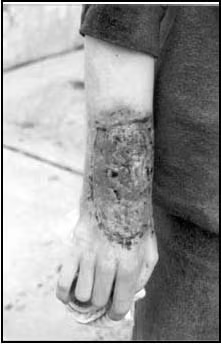
Many lab cooks do not take basic lab safety precautions. Using heat to process chemicals poses a higher risk of explosion, although indirect heat in the processing area—such as from smoking, electrical switches or even equipment-generated friction—can also trigger explosions. In addition, police forced entry into labs can cause explosions—some accidental, and some triggered by booby traps set by lab operators.[4] (The published literature commonly reports that lab operators are often well-armed, but how many shootings occur during lab seizures is unknown.) Despite a decrease in the number of reported fires and explosions over the past few years, the number of police injured when responding to methamphetamine labs increased during that time.[5] Poor lab ventilation increases the risks both of explosions and of toxic fume inhalation. On the other hand, good ventilation spreads toxic fumes outside, where they put other people at risk. Heating the chemical red phosphorous can create phosphine, a deadly gas.
About three to six people working in clandestine U.S. methamphetamine labs die each year from explosions, fires or toxic fumes.[6] One out of every five or six labs discovered is found because of an explosion or fire.[7] A survey of those who cook methamphetamine revealed one-quarter had experienced a fire while cooking and, in one-fifth of these, no emergency services were called.[8] Those present tended to leave the premises without warning others, which is particularly dangerous in multiunit buildings.
Environmental Hazards
Each pound of manufactured methamphetamine produces about 5 to 6 pounds of hazardous waste.[9] Clandestine drug lab operators commonly bury or burn the waste on or near the site, or dump the waste along the road or into streams or rivers.[10] Others pour waste down the drain, place it in household or commercial trash, or store it on the property. Dumping toxic waste into trashcans and commercial dumpsters puts sanitation workers at risk. The water used to put out lab fires can also wash toxic chemicals into sewers. In addition, toxic waste can be transferred from surfaces and equipment onto the body and clothing of those in contact with the lab, and can subsequently contaminate other locations.[11] More research is needed to understand this toxic dumpings long-term environmental effects.[12] Residual contamination of the ground, water supplies, buildings, and furniture may last for years.
Child Endangerment
Many jurisdictions are now finding that children are commonly exposed to the hazards of clandestine methamphetamine labs.[13] In 2003, police found more than 3,000 children at methamphetamine lab sites.[14] Young children frequently put their hands in their mouths, have higher metabolic and respiratory rates than adults, and have developing central nervous systems, all leaving them vulnerable to harm from inhaling, absorbing, or ingesting toxins from chemicals.[15] About two-thirds of children found at labs seized by police tested positive for toxic levels of chemicals in their bodies.[16] Others suffer burns to their lungs or skin from chemicals or fire. Some have died in explosions and fires. Many are badly neglected or abused by parents suffering from drug abuse's effects. (Senior citizens whose caretakers are lab operators are similarly vulnerable. Pets, including guard dogs, can also be harmed.) When police agencies start targeting labs for investigation and seizure, social service agencies and family courts should be prepared for increased workloads, as well.[17]
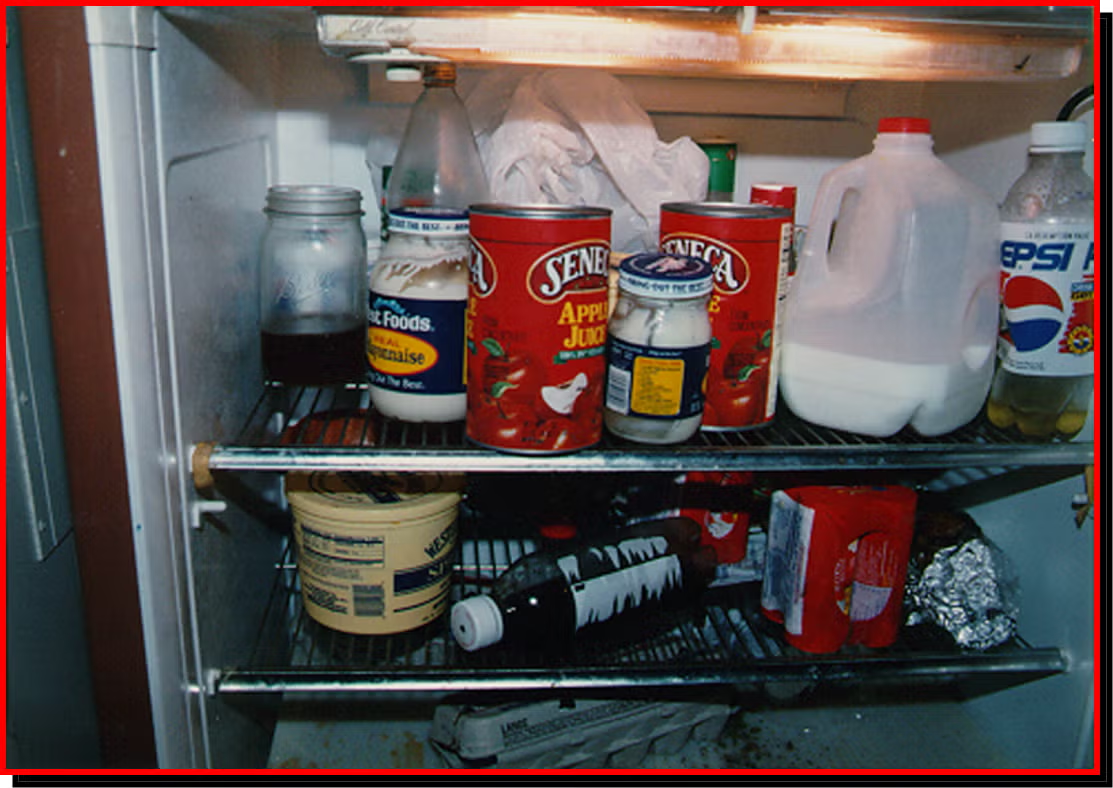
Types of Clandestine Methamphetamine Labs
There are two main types of clandestine methamphetamine labs. One is the "super" lab—a large, highly organized lab that can manufacture 10 or more pounds of methamphetamine per production cycle. To date, super labs are concentrated in southern California and Mexico.[18] The other type is small-scale labs, often referred to as "mom and pop" or "Beavis and Butthead"§ labs. These labs can manufacture only 1 to 4 ounces of methamphetamine per production cycle. Their operators typically produce enough drugs for their own and close associates' use, and just enough extra to sell to others to finance the purchase of production chemicals. A third, though far less common, type of lab called a "dirt lab" has emerged in recent years. Small-scale lab cooks seek out areas where super labs dump their toxic waste, dig up the soil, and try to extract the residual methamphetamine.[19]
§ For readers not of the MTV generation, Beavis and Butthead are portrayed as two moronic teenage television cartoon characters. The characters are not connected to illicit drug manufacturing in the program. Their personalities simply remind some drug enforcement officials of the personality profiles of clandestine drug lab operators and illicit drug users.
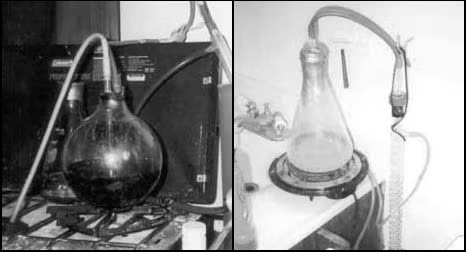
Smaller labs can be set up with basic lab equipment and household appliances. Salt Lake City Police Department
Generally speaking, the two lab types present different challenges for police. Although perhaps 90 percent of all labs are of the small-scale type,[20] the super labs account for up to 80 percent of all methamphetamine produced.[21] So, from a supply-control perspective, they are of far greater concern. However, the small labs account for far more explosions, fires, uncontrolled hazardous waste dumping, and child endangerment. This is largely because less-skilled cooks operate the small labs, using more-primitive equipment and facilities. Many small-lab cooks are parents and methamphetamine abusers themselves, and their drug dependency leads them to neglect their children's welfare. So, if the challenge is to reduce explosions, fires, environmental damage, and child endangerment, then the small labs are of greater concern.
Emergence and Spread of Clandestine Methamphetamine Labs
Clandestine labs have manufactured illicit drugs since at least the 1960s, but the problem has become much more widespread in the past 15 years or so, largely because of methamphetamine's growing popularity.[22] Perhaps the main reason methamphetamine has become so popular is that it is now simpler to produce: detailed instructions for doing so are readily accessible on the Internet, and new manufacturing methods allow production from an assortment of reasonably easy-to-acquire chemicals.[23] Consequently, an increasing number of people have set up labs to produce methamphetamine for their own use. Because methamphetamine is very addictive, the more people who experiment with it, the more people who become dependent on it, and the more demand there is.
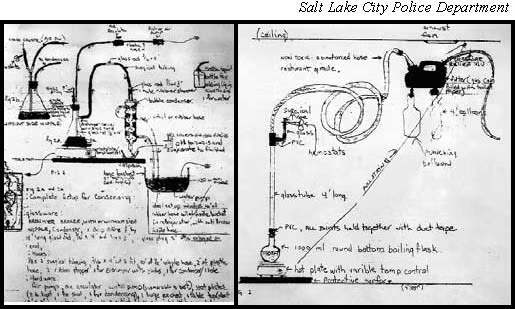
Instructions for manufacturing illegal drugs are now readily accessible on the Internet.
Methamphetamine production in clandestine drug labs was prevalent in California, and in and around Philadelphia, in the 1980s.[24] Southern California remains the predominant manufacturing region, but production has since spread to many other areas in the United States. Both Mexico and California have "super labs". Some drug organizations prefer to manufacture methamphetamine in California because they then have to smuggle only the production chemicals across the border, rather than the finished product (the penalties for smuggling methamphetamine are more severe).[25] Methamphetamine manufacturing and abuse are now considered serious problems in nearly all parts of the United States. Police have now seized labs in all 50 states.[26] The National Clandestine Drug Laboratory Database was established in 1999 to monitor lab-related trends.[27],§
§ The El Paso (Texas) Intelligence Center houses the database, which federal, state and local police agencies can access.
Labs are now routinely found in all sorts of environments—from rural farms and fields to suburbs, to urban centers.[28] Operators often set up labs in rental property, including farmhouses, apartments, hotels and motels, and self-storage units. Thus, they can move quickly, avoid the risk of losing property to asset forfeiture, and avoid the risk of being held liable for hazardous material cleanup costs.[29] Small labs are even found in vehicles. Small labs are highly mobile; operators can set up and dismantle them with relative ease.
Outlaw motorcycle gangs dominated methamphetamine production until Mexican drug trafficking organizations began to use their cocaine and marijuana production, smuggling and distribution networks to expand into the methamphetamine trade.[30] Although some motorcycle gangs still produce methamphetamine, many others now serve as distributors for the Mexican organizations. These organizations can acquire some of the production chemicals—notably, ephedrine and pseudoephedrine—in bulk quantities on the international market because, until recently, Mexico has not sought to effectively control the importation of these chemicals, unlike the United States and other countries.[31]
Factors Contributing to Clandestine Methamphetamine Labs
Understanding the factors that contribute to your problem will help you frame your own local analysis questions, determine good effectiveness measures, recognize key intervention points, identify key stakeholders, and select appropriate responses.
Commonly Used Chemicals and Cooking Methods
Drugs manufactured in clandestine labs are the product of mixing chemicals. Lab operators must either procure or manufacture those chemicals—be they essential or precursor.§ An estimated 34 different chemicals can be used to produce methamphetamine.§§ Among the most common are ephedrine, pseudoephedrine, phenylpropanolamine, red phosphorous,§§§ iodine, hydrochloric acid, ether, hydriodic acid, and anhydrous ammonia. Some of these chemicals are also used to produce other illicit drugs. The United States does not manufacture ephedrine, pseudoephedrine, and phenylpropanolamine; all supplies of these chemicals originate in other countries.§§§§
§ Essential chemicals do not remain part of the final product's chemical structure, whereas precursor chemicals do (Sevick 1993) [PDF]
§§ See Sevick (1993) for a comprehensive list of essential and precursor chemicals, and Bureau of Justice Assistance (1998) [PDF] for descriptions of the chemicals' toxic effects. See Manning (1999) [PDF] for detailed descriptions of the stages of the methamphetamine production process, the chemicals required, the chemical processes, and the respective hazards of each chemical and process.
§§§ Recently, hypophosphorous acid has been used as an alternative to red phosphorous. The use of hypophosphorous acid significantly increases the risk of fire (Valle, Ikegami and Crisp, 2003).
§§§§ Germany is the largest producer of ephedrine; China and India are major exporters of ephedrine and pseudoephedrine; and Taiwan and Japan are major exporters of phenylpropanolamine. Most of the ephedrine smuggled into the United States comes through Mexico (U.S. Office of National Drug Control Policy 1998).
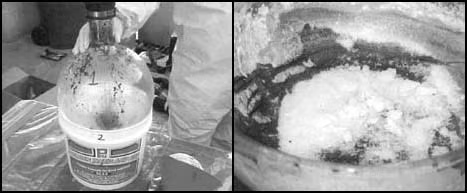
A variety of chemicals such as red phosphorous, seen here on the left, can be used to produce the methamphetamine, seen here on the right. Credit: Salt Lake City Police Department
The essential and precursor chemicals can be diverted into the illicit drug market in various ways, among which are the following:
- Stealing the chemicals
- Smuggling the chemicals across international borders
- Labeling chemicals fraudulently
- Bribing or coercing government officials, chemical manufacturers and distributors, or deliverers
- Creating complex transaction chains that make it difficult to track the chemicals
- Buying the chemicals from legitimate chemical suppliers who, for various reasons, sell indiscriminately
- Buying chemicals through undocumented cash transactions
- Converting similar, unregulated chemicals into the desired, regulated chemicals
- Storing chemicals in warehouses long enough for police and regulators to give up trying to track them
- Trading in amounts just below the thresholds that trigger reporting and recordkeeping requirements (a practice known to regulators as "smurfing").[32]
Police and other regulators should be alert to suspicious business practices that might indicate attempts to divert chemicals to clandestine methamphetamine labs.§ Chemical manufacturers, wholesale and retail distributors, freight handlers, agents, and brokers are all potential sources from which chemicals can be diverted. They can be diverted from factories, import and export points, transportation systems, and disposal and recycling plants.
§ See Sevick (1993) [Full text]for a description of some indicators.
Lab cooks can derive some of the chemicals needed to produce methamphetamine from materials available for purchase without regulation at retail outlets.§§ Among these materials are cold and allergy medications,§§§ lye, rock salt, battery acid, lithium batteries, pool acid, iodine,§§§§ lighter fluid, matches, fireworks, road flares, antifreeze, propane, paint thinner, and drain cleaner. (Commonly used equipment includes glass jars, rubber tubing, sports drink bottles, coffee filters, gasoline cans, hotplates, and pillow cases.)
§§ Curiously, retailers with no history of catering to the needs of cold sufferers, such as tobacco stores, arcades, clothing stores or pet stores, may carry products containing pseudoephedrine (Minton 2005).
§§§ Some jurisdictions are starting to impose—and some vendors are voluntarily adopting—quantity restrictions on purchases of these medications (see response 6).
§§§§ Iodine solution is commonly used in the shoeing of horses.
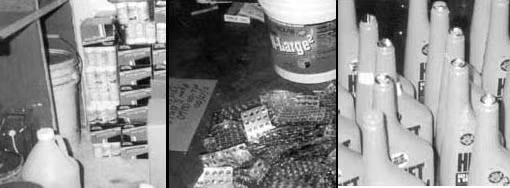
Some of the chemicals needed to produce methamphetamine can be derived from products available for purchase without regulation at retail outlets. Credit: Salt Lake City Police Department
There are three main cooking methods for producing methamphetamine:
- The phenyl-2-propanone (or P2P) method
- The red phosphorous (or red P) method§
- The Nazi dope§§ (or lithium or sodium reduction) method.
§ The red phosphorous method used to be termed the "cold cook" method, but this can be misleading: cooks may or may not use heat to speed up the cooking process.
§§ This reference is to the use of ephedrine and pseudoephedrine to stimulate German troops in World War II (Snell 2001).
The phenyl-2-propanone method is less common today, largely because its main precursor chemical, phenyl acetic acid, has been strictly regulated and is hard to obtain; it takes longer to produce methamphetamine;§§§ and it produces a less pure and less potent form of the drug, a form with worse side effects.[33] Most methamphetamine cooks now use the latter two methods, in which ephedrine or pseudoephedrine is the main precursor chemical.[34] Ephedrine and pseudoephedrine are comparatively easier to obtain: they are commonly found in cold and allergy medications. The red phosphorous method also uses iodine. In addition, the Nazi dope method also uses lithium or sodium metal strips and anhydrous ammonia, an agricultural fertilizer, to synthesize the ephedrine or pseudoephedrine. Thefts of anhydrous ammonia from farmers' storage tanks are almost always connected to methamphetamine production.[35] The terms for these various methods can be confusing; they are sometimes confused even in the published literature. Police will need in-depth training in the chemical processes to fully understand the different ways methamphetamine is produced.
§§§ Lab cooks using ephedrine or pseudoephedrine can make a batch of methamphetamine in anywhere from two to 12 hours (depending on the batch's size and whether the cooks use heat to speed up the process); it takes about twice as long using phenyl-2-propanone (Institute for Law and Justice and 21st Century Solutions 2000 [Full text]; Campbell Resources Inc. n.d.).
Offenders
Although many people can learn to produce small batches of methamphetamine, relatively few develop the skills necessary to manufacture large, high-quality batches. Few clandestine methamphetamine lab cooks have much, if any, formal chemistry training.[36] Most learn from other offenders, including family members, or by following instructions obtained from underground sources. [37], § Some lab operators do their own cooking; others hire cooks. Some cooks hire themselves out to several drug trafficking organizations, getting paid in either cash or a portion of the drugs they produce. The average cook in a study of small-scale labs made about four to six batches of methamphetamine per month, producing about 12 pounds of the drug and 77 pounds of toxic waste per year.[38] Most cooks are male, in their 30s, and of middle and lower socioeconomic statuses.[39] Methamphetamine users who also produce or sell the drug are likely to seriously abuse it.[40]
§ Within three years, an estimated 250,000 people were taught to cook methamphetamine in the Los Angeles area. The internet plays a relatively minor role; most cooks learn from a friend or relative. The average cook teaches someone else to cook methamphetamine about once every 90 days (Valle, Ikegami, and Crisp 2003).
In addition to the lab operators and cooks, other people may be employed to buy and store chemicals, lease property, procure and set up equipment, and perform other production tasks. The four main lab roles are those of the operator (or foreman), the cook, the workers who perform many of the menial and dangerous tasks, and the security staff.[41] Operators commonly target low-income people, often immigrants, to lease their property for temporary use as a lab or to work in a lab.[42] Some loose, informal networking exists among lab operators and cooks, who share information and employees.[43]
Time and Day Patterns
As with most crime problems, methamphetamine production has peak periods. Although there are no national data, one jurisdiction found that approximately two-thirds of the methamphetamine produced was cooked between 6 p.m. and 6 a.m.[44] Most cooks said they preferred to cook on the weekdays, not on the weekends, a pattern which was consistent with police lab-seizure data showing a spike on Tuesdays and Wednesdays. Identifying temporal trends can help to identify days and times with higher risks of lab fires and explosions.
Profitability of Clandestine Methamphetamine Labs
By most accounts, clandestine methamphetamine labs can be highly profitable.[45] A modest investment in chemicals, equipment, and labor can yield substantial profits in wholesale or retail methamphetamine sales, although profit estimates vary considerably.[46] Some of this variation depends on the availability of chemicals, the purity of the methamphetamine, the regions of the country where the drug is manufactured and sold, and the size and sophistication of the lab.
Methamphetamine's wholesale and retail costs likewise vary, with official estimates as follows:
- $20 to $300 for 1 gram
- $270 to $5,000 for 1 ounce
- $1,600 to $45,000 for 1 pound.[47]
However, most cooks in small-scale labs manufacture methamphetamine for their own personal use, rather than for street sales.[48]
Cleaning Up Clandestine Methamphetamine Labs
Cleaning up clandestine methamphetamine labs is an enormously complex, time-consuming and costly undertaking.§ Seizing a lab potentially makes a police agency liable for some of the costs of cleaning up on-site hazardous materials.[49] If the lab is operating when police find it, it must first be safely neutralized so that it does not explode or chemically contaminate the environment. Then, the immediate and apparent hazardous-materials must be cleaned up and disposed of safely. Police usually contract with certified hazardous-material disposal companies for this task. Seizing even a small lab can take four or more hours. Storing evidence and conducting laboratory analysis of chemicals are similarly time-consuming and costly. Many jurisdictions are finding that the demands of processing evidence are straining their forensic laboratory resources.[50] Finally, there is the question of a more permanent cleanup (or remediation) of the site to eliminate the long-term hazards posed by residual chemicals. Much is still unknown about such hazards, so we do not fully know how serious the risks of exposure to contamination are. Consequently, many issues regarding the costs and responsibility for cleanup remain unsettled. There are few, if any, established standards for acceptable contamination levels.[51] Complete remediation is seldom done because of the cost, and owners abandon some property rather than undertake that task.[52] Public health and environmental officials, rather than police, will likely have to take the lead on remediation. New legislation or regulations may be required to establish and enforce remediation standards.
§ Among the useful publications on the technical aspects of lab clean up are Hannan (2005) and Vandeveld (2004).
All emergency responders to clandestine methamphetamine labs, police included, must be properly trained and equipped.§ The costs of training and equipment are substantial. Many police agencies remain ill-prepared to seize the labs.
§ In the United States, the Occupational Safety and Health Administration has established guidelines and requirements that govern exposure to clandestine drug labs (see the Code of Federal Regulations at 29 C.F.R. 1910.120). The U.S. Drug Enforcement Administration, Environmental Protection Agency and Coast Guard (1990) have jointly published a document titled Guidelines for the Cleanup of Clandestine Drug Laboratories [PDF], available to police agencies.
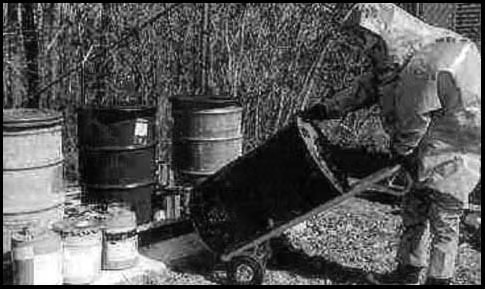
Disposing of chemicals at clandestine drug labs requires special training and equipment. Credit: Salt Lake City Police Department
The average cost of cleaning up the immediate and apparent hazardous materials in an average-sized clandestine methamphetamine lab ranges from $2,500 to $10,000.[53] It can cost up to $150,000 to clean up hazardous materials in the larger super labs. Thorough decontamination of even an average-sized site has been estimated to cost around $50,000.[54] Some statutes allow prosecutors to try to recover the cleanup costs from convicted defendants.[55] Federal and state funding that might be available to help local jurisdictions with immediate cleanup costs typically does not cover long-term remediation costs.
Free Bound Copies of the Problem Guides
You may order free bound copies in any of three ways:
Online: Department of Justice COPS Response Center
Email: [email protected]
Phone: 800-421-6770 or 202-307-1480
Allow several days for delivery.
Email sent. Thank you.
Clandestine Methamphetamine Labs 2nd Ed.
Send an e-mail with a link to this guide.
* required
Error sending email. Please review your enteries below.
To *
Separate multiple addresses with commas (,)
- Your Name *
Your E-mail *
Copy me
Note: (200 character limit; no HTML)
Please limit your note to 200 characters.